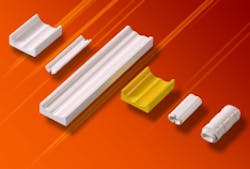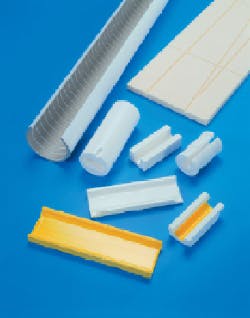LASER MATERIALS: Alumina ceramic enhances laser pump cavities
JOHN CLOUTIER
In the nearly five decades since the first laser was demonstrated, many types of lasers have been successfully commercialized for applications ranging from scientific and military to medical and consumer electronics. Worldwide, more than 100,000 medium- to high-powered lasers are sold each year for medical and industrial use, in addition to the one billion low-power (usually semiconductor) devices used in laser pointers, printers, CD/DVD players, and barcode scanners.
A typical nonsemiconductor-laser gain medium is pumped by an external energy source, such as a flash lamp, electrical discharge, or another laser. The gain medium can be contained within a pumping chamber, which is itself inside the optical cavity or resonator. In its simplest form, a pump cavity is shaped in the form of a tube with two parallel mirrors (a high reflector and a partial reflector) facing each other at each end.
The design and construction of the pump cavity is critical to the performance of the laser; for medium-to-high-power lasers, it is also important to the laser's durability. For many of these lasers, including several of the most common types used for industrial, commercial, and military applications, the optical cavity is often made from alumina (aluminum oxide) ceramic. Alumina (Al2O3) has the advantage of high mechanical strength, high reflectivity, resistance to chemical attack, and a low coefficient of thermal expansion.
However, different types of lasers have varying requirements for the pump cavity, necessitating specialized ceramic components with specific material composition and manufacturing techniques (see Fig. 1). For instance, solid-state lasers use reflectors constructed of a specific grade of alumina selected for its high reflectivity, while excimer lasers use insulators constructed of very-high-purity alumina that is highly chemical resistant and able to withstand extreme temperature shock.
Solid-state lasers
Because solid-state lasers are optically pumped (for example, with flash lamps or laser diodes), the surface of the pump cavity must have high reflectivity to maximize the transfer of radiation from the pump source to the laser rod. Indeed, the efficiency of this radiation transfer determines to a large extent the overall efficiency of the laser system. For this reason, the pump cavity of a solid-state laser is often called a "reflector."
The cavity walls must have high reflectivity at the absorption bands of the particular laser material. Ceramic reflectors manufactured from Sintox AL—a high-purity (99.7% Al2O3) porous material—work particularly well for lasers using ruby (694 nm) and Nd:YAG (1064 nm) crystals, as well as for intense-pulsed-light medical- and aesthetic-laser systems. Independent tests of Sintox AL alumina have shown reflectance figures in excess of 96% (typically 97% to 98%) over the relevant wavelengths from 500 to 2000 nm. The material provides a highly diffuse reflectance, behaving as a bulk reflector of the source radiation by both reflecting and refracting light back into the cavity.
Cooling
Pump radiation that has a longer wavelength than the stimulated emission does not contribute to the laser output but does heat up the laser crystal, which causes optical distortions that affect the quality of the laser output. Consequently, cavities are often water or liquid cooled, and therefore need to be able to withstand the erosive action of the fluid, absorb the generated heat, and remain dimensionally stable.
Sintox AL alumina reflectors are typically glazed both inside the cavity and around the outer edges using a highly reflective glaze that seals the ceramic against ingress of cooling fluids that may alter the refractive index, introduce impurities, and reduce reflectance and efficiencies. We have developed special manufacturing techniques to overcome the challenges of uniformly applying the glaze while maintaining high reflectivity and tight dimensional tolerances.
In addition to the sealing function, glazes can also act as filters; for example, one version consists of yellow glazed reflectors in which the visible yellow color is complementary to the spectral colors of violet and indigo, which are effectively absorbed up to a wavelength of approximately 450 nm.
Reflectors for solid-state lasers can also be made of gold-plated aluminum. These reflectors are less expensive to purchase, but need to be replaced more frequently because of delamination problems. Any peeling of the gold coating results in a loss of uniform reflectivity. Alumina reflectors typically last about five times longer because the ceramic substrate and the glazing material have similar coefficients of thermal expansion.
Low-power solid-state lasers, such as those used to measure distances, sometimes use reflectors made of polytetrafluoroethylene (PTFE), a synthetic fluoropolymer known by the DuPont brand name Teflon. While less expensive than alumina, PTFE is relatively soft and vulnerable to scratches that diminish reflectivity, especially during maintenance in the field.
Carbon dioxide lasers
Carbon dioxide (CO2) lasers also commonly use pump cavities constructed of alumina ceramic. The CO2 laser was one of the earliest gas lasers to be developed, and it is still one of the most powerful and efficient, with a ratio of output power to pump power as large as 20%. Producing a beam in the infrared and microwave region of the spectrum (from 9.4 to 10.6 µm), CO2 lasers of high-enough power can melt through or burn many materials upon which they are focused.
In CO2 lasers, the pump cavity is called a waveguide. The waveguide channels the photons into a coherent beam, so the waveguide must be very straight and properly aligned. The bore of the waveguide contains a gas mixture that is excited by radio-frequency energy and generates a plasma that emits photons. Alumina ceramics are well suited for this application because they exhibit excellent optical properties at the 10.6 µm wavelength and because they have high mechanical strength and the ability to withstand working temperatures in excess of 1000°C.
During the past decade, new waveguide designs have dramatically improved the performance and size ratio of CO2 laser engines (see Fig. 2). For example, a "folded" waveguide design in the shape of the letter "Z" produces the same output as a conventional straight-line channel while occupying only one-third the space. The overall size of the entire laser engine, including the cooling system, is also reduced in proportion. A further benefit of this compact design is that it offers highly efficient heat extraction, allowing the laser to be air cooled or liquid cooled.To fabricate CO2 waveguides in such complex shapes, we use state-of-the-art grinding equipment to create highly precise grooves and fabricate intricate internal structures. It is critical that precise dimensional tolerances are maintained to ensure that the bores properly guide the photon beam and to guarantee a tight seal of the gas medium.
Excimer lasers
Another type of laser that uses an alumina ceramic pump cavity is the excimer laser, which typically relies on a combination of a reactive gas such as fluorine or chlorine and an inert gas such as argon, krypton, or xenon. When pumped with an electrical stimulation, a pseudo-molecule called a dimer is created, which can only exist in an energized state and can give rise to laser light in the ultraviolet range. The very short pulse duration (10 ns) disintegrates surface material through ablation rather than burning and causes almost no heating or change to the underlying and surrounding material. Excimer lasers are widely used for eye surgery and dermatological treatment, as well as for lithography in semiconductor manufacturing, because the light is exceptionally well focused and capable of very precise and delicate control, and is well absorbed by biological matter and organic compounds.
The excimer-laser pump cavity is formed by alumina ceramic insulators. The exceptional dielectric strength of high-purity alumina makes it an excellent insulator. We fabricate insulators made of 96.7% to 99.5% pure Al2O3, with 10 to 20 (sometimes as many as 50) precisely placed and sized bores for electrical feedthroughs. The excimer-laser insulators must be precisely fabricated because, like their CO2 counterparts, the insulators serve as waveguides that channel the photons into a coherent beam.
High-purity alumina ceramic has the advantage of being inert to highly aggressive gaseous halogens. The material has no organics to pollute the laser gas and reduce the insulator's working life, and is able to withstand extremely high temperature shock of excimer-laser pulses. These excimer-laser insulators also provide excellent dimensional stability, with volume resistivity exceeding 1014 ohm cm.
John Cloutier is business development manager, Eastern Region, Morgan Technical Ceramics, 232 Forbes Road; Bedford, Ohio 44146-5418; e-mail: [email protected]; www.morgantechnicalceramics.com.

